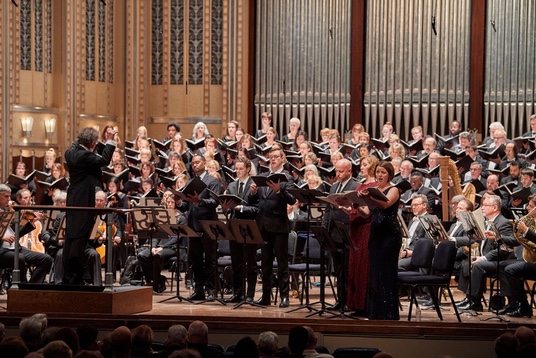Thu 3/16 & Sat 3/18
There’s a lot more to Russian composer Igor Stravinsky than his famous Rite of Spring (though possibly, that’s enough trendsetting music for any young composer to be known for — and he was young and near the beginning of his career in 1913 when it premiered in Paris).
In two Severance Hall concerts set on either side of St. Patrick’s Day, the Cleveland Orchestra led us down a musical path that revealed how Stravinsky’s music changed over the years. Why the shift in formula? Perhaps he either got bored with doing the same thing. Program notes by David Wright suggest it was because of his “religious revival.” Whatever the reason, it was a “new” Stravinsky for some of us.
Franz Welser-Möst conducted the orchestra (and later, the Cleveland Orchestra Chorus prepared by Robert Porco) in this exploration of Stravinsky’s quite varied creations. First up was “Fireworks, Opus 4” (1908), a romantic explosion (lasting almost five minutes), written while he was still under the influence of his teacher Rimsky-Korsakov. In this piece, even something as simple as watching the choreography of bow strokes as the melodic theme shifted between the various string sections turned mesmerizing. The piece ended with a satisfying “thump” (suggesting fireworks exploding?).
Almost twenty years later, after leaving Russia and moving to the United States, Stravinsky composed the next piece, “Apollon Musagete” (1928). This ballet-oriented work fits into the “neoclassical” mainstream then dominating contemporary music. Here William Preucil’s solo violin (as “Apollo”), accompanied by various muses (including ones represented by principal cellist Mark Kosower and by associate concertmaster Jung-Min Amy Lee), brought sparkling life to the ballet (even if sans dancers).
Next came a slightly earlier piece, “Symphonies of Wind Instruments.” It’s a 1920 creation that sounds “modern” (that is, direct and dispassionate, nothing like the romantic Russian compositions). The change in style for Stravinsky as he became “modern” might be compared to the difference between an early Picasso (say “LaVie,” 1903, held by the Cleveland Museum of Art) and a late one (such as “Bull Skull, Fruit, Pitcher,” 1939, also in the CMA). Modernism infected (or graced, depending on your taste) all the arts.
Ah, but time for yet another change. The last work, “Threni: Lamentations of Jeremiah” (1957-1958), provided a challenge for both audience and orchestra. Before the piece began, Welser-Möst remarked that it was “hellishly difficult” and that’s why it’s rarely heard. In fact, this was the orchestra’s first performance ever of the work.
It was, in many ways, the most delightful of all. Six rich-voiced, beguiling vocalists from Seraphic Fire, a Florida ensemble directed by Patrick Dupre Quigley, and a stage-filling Cleveland Orchestra chorus, both spoke and sang biblical verses from the book of Jeremiah the prophet. This fine, complex piece (yet straightforward in structure) featured letters from the Hebrew alphabet, and Latin text (English translations were in the program).
Stravinsky once said, “The trouble with music appreciation in general is that people are taught to have too much respect for music. They should be taught to love it instead.” This intriguing concert offered something to love for every taste (plus, it was educational — sorry Stravinsky, it was a bit like music appreciation class, something I enjoy).
The Cleveland Orchestra sound (rich, full, precise — all good, always) makes it easy to find something to love even if listeners don’t know what to expect from new pieces (to them) and this program showed that. And Seraphic Fire? I’d love to hear more from this ensemble.
[Written by Laura Kennelly]
Case Western Reserve University, Cleveland, OH 44106
